The most effective compression socks for varicose veins should cover the entire affected part of your leg, but don’t buy the first ones you get your hands on.
Read our ultimate guide to combating the disease using this inexpensive method and learn all about choosing the best ones for you.
Among other things, you’ll need to consider the fabric, appearance, and length, and other qualities before making your purchase.
Mid-level, knee-high socks usually work well, but always check with your doctor to make sure you are wearing the right one for your particular case.
Are you falling down the rabbit hole looking for the best solution?
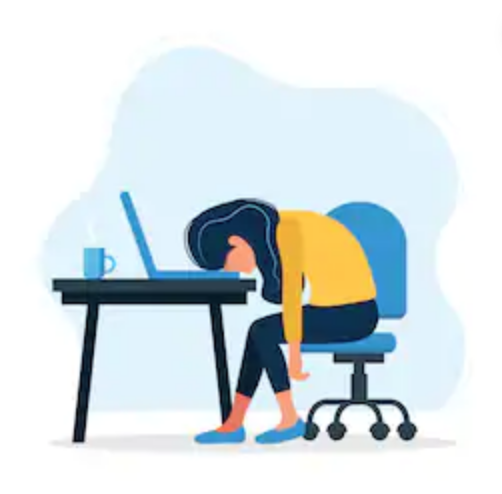
When you search “best treatment for varicose veins” or “best compression stockings for varicose veins” on Google, all kinds of remedies show up on the search results pages. The solutions run the gamut of tinctures, treatments, and the least invasive – compression stockings and socks.
Your search will likely return a wide range of selections and answers. Before you know it, you are falling down the “compression stockings/compression socks” rabbit hole, and your research turns into a nightmarish task.
You end up reading article after article, hoping to compile the most accurate answer to your question and finally figure out which pair to spend your money on. Does this sound familiar? You’re in luck then!
This ultimate guide will save you the fuss of going through 20 or 30 articles or even more because this is the best compression stockings/compression socks guide for you.
Wait. What exactly are compression stockings and socks?
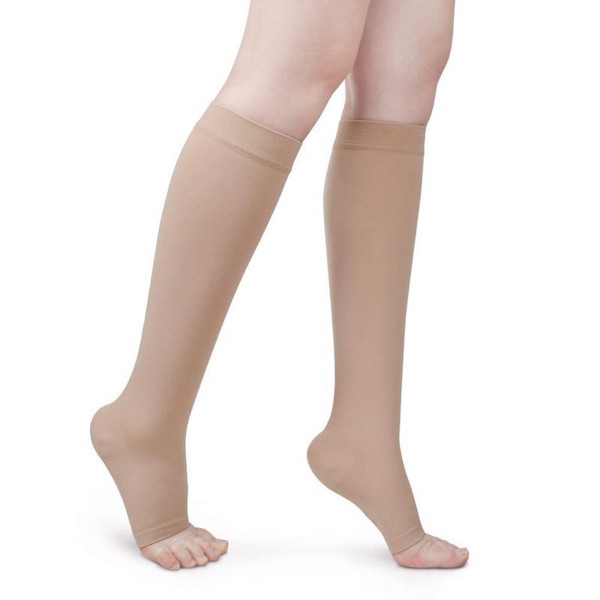
Compression stockings and compression socks are medical aids designed to alleviate or improve the pressure on the lower limb veins and venous valves to move blood circulation upwards to prevent blood clots.
Simply put, they act as a non-evasive decompression treatment to help prevent diseases associated with poor lower limb blood circulation.
Many people use them to combat diseases
Besides varicose veins, compression socks and compression stocks are used to treat these common ailments:
- Edema
- Venous reflux disease (Chronic venous insufficiency)
- Deep Vein Thrombosis
- Lymphedema
- Phlebitis
- Lipodermatosclerosis
- Diabetes
What are they made of, and what makes them effective?
Compression socks and stockings are made from various materials. These can be nylon, cotton, spandex, or natural rubber microfibers, which create a sheer product that allows the skin to breathe in different conditions. More premium ones have silver textile threads woven into them, which provide anti-microbial protection.
The woven fibers produce materials in different combinations and thicknesses, depending on the desired elasticity, softness, and appearance. The fabric content, compression level, feel, and the desired appearance determine the final stocking, sock, or pantyhose design that meets a specific purpose.
Avoid these common “disasters”
Compression stockings are knitted with lesser denier units, making them less durable than compression socks; they get damaged easily. Be careful, then, when putting on boots or shoes that require zipping.
Watch those fingernails, too, unless you like to end up with something that looks like one of the world’s most famous buildings.

Types and Lengths
These days, compression socks and stockings come in different colors, designs, and lengths. You’re bound to find one that complements the outfit you are wearing.

The types can vary, too. They include knee-highs, thigh-highs, pantyhoses, close-toed and open-toed types, among others. Color-wise, the most common ones usually come in neutral colors like nude, black, and white.
How Long Should You Wear Them?
If we can give you one piece of advice about wearing compression stockings or socks, it’s to not overwear them daily.
People use compression stockings to replace their ordinary hosiery while helping promote better blood circulation. However, wearing them too long and too often may create an opposite effect on your body; it might just further constrict blood circulation.
Unless medically advised, limit your time wearing them to 8-10 hours a day and take them off when you go to bed.
Popular Articles on ComproGear
Best Compression Socks for Sitting All Day Compression Socks for Sitting All Day
Medical Compression Socks Medical Grade Compression Stockings
What Level of Compression Socks Do I Need? Levels of Compression Socks
Best Compression Socks for Nurses Best Compression Socks for Nurses
What Are The Best Compression Socks for Circulation? Best Socks for Bad Circulation
Edema Socks Compression Socks for Edema
Swollen Feet? Compression Socks for Swollen Feet
Compression Stockings mmHg Chart Different Types of Compression Socks
Super Plus Size Compression Stockings Compression Socks for Short Fat Legs
Know the difference
When searching online, you might find yourself getting lost between compression stockings and compression socks. What’s the difference between the two, if any?

Simply put, both function using the same principle.
They are both medical aids that help treat venous reflux disease, varicose veins, and other related diseases associated with poor blood circulation on the lower extremities, without the need for surgeries. What differentiates one from the other is only the thickness and sheerness of the material used to create both products.
One possesses typical sock-like textures while the other highlights the sheerness of the usual female hosiery.
As you can imagine, compression stockings manufacturers typically market to women, while compression socks manufacturers typically market to both men and women.
What’s the science behind compression socks/stockings and their role in helping combat poor circulation-induced diseases?
Compression socks and stockings work by applying evenly-distributed pressure on your lower limbs. This gentle squeezing action to your legs accelerates blood flow and circulation, which in turn helps prevent blood clots and swelling.
As an addition to your wardrobe, these items may help you maintain healthy blood circulation, recover from surgery, or overcome limited mobility. Their role in healthy blood circulation may also prevent the formation of ugly varicose veins and possibly even save you from deadly heart conditions such as heart attacks and strokes.
A quick, scientific look
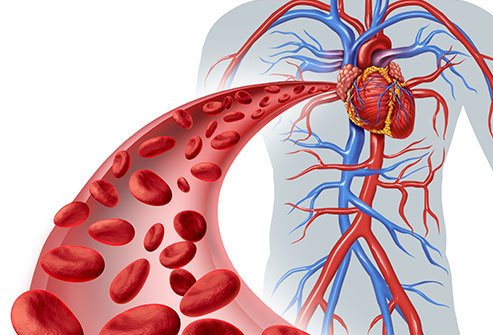
Here’s what happens during your body’s blood circulation process:
Blood is pushed through the body by the heart pumping it through the veins, helped by the rhythmic movement of smooth muscle in the vessel wall and skeletal muscle as the body moves.
The blood circulation process starts with the heart pumping blood through the veins as the body moves. As this happens, blood is “pushed” to the different parts of the body. This action is aided by the rhythmic movement of smooth muscles in the vessel walls and skeletal muscles.
Since veins must move blood against the pull of gravity, blood can’t flow backward through its one-way valves. By nature’s design, skeletal muscle movements help in venous blood circulation, underscoring the importance of frequently getting up and moving after long periods of sitting, so that blood will not pool in your lower extremities.
Normal vs damaged valves have a huge impact on blood circulation
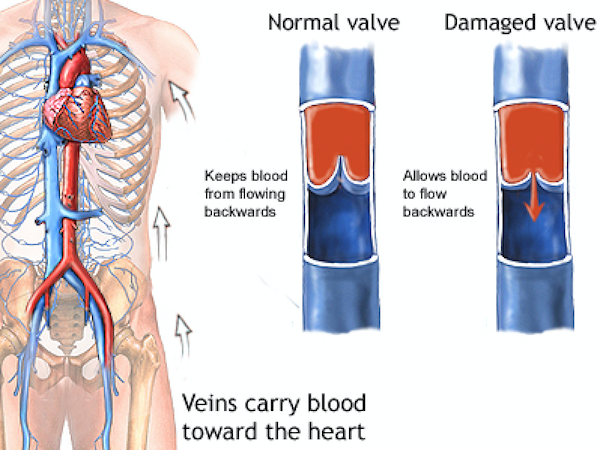
Once your muscle contractions weaken and your veins become damaged, the valves do not function the way they should. By this time, they don’t pump blood properly back to the heart while working against gravity.
This disruption in blood flow ultimately affects the distribution of oxygen to your heart and brain. Sometimes, this manifests in that feeling of lightheadedness when you stand up.
Over time, this disruption can cause different types of damage to your body, which lets you know through the emergence of various diseases, with some more severe than others.
A deeper look at what happens when damaged vein valves prevent blood from flowing upwards
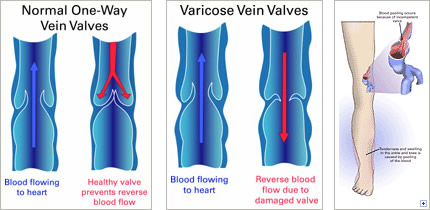
The most common reaction of blood not flowing upwards properly is venous reflux disease, known to be caused by long hours of standing and sitting at any one time.
When your body fails to push blood back towards your heart, the blood goes backward and pools in the veins, causing them to stretch or twist. This condition can worsen, and the veins become visible underneath the skin, which is the physical manifestation of varicose veins.
The ugly truth about varicose veins
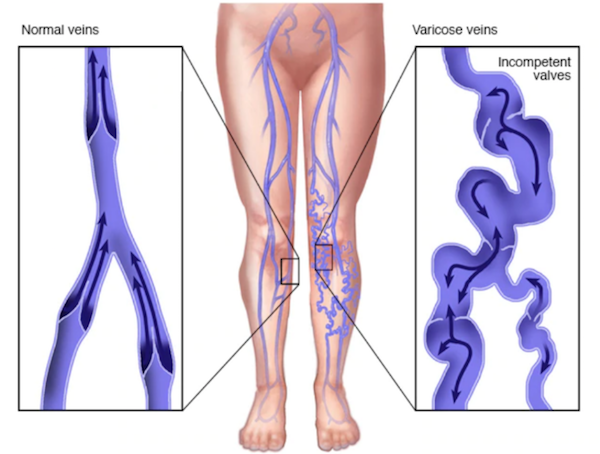

Varicose veins appear swollen and twisted, commonly caused by blood stasis and weak vessel walls. They can also occur in various parts of the body besides the legs.
They might appear as clusters of blue or purple veins visible underneath the skin and are sometimes surrounded by thin red capillaries known as spider veins.
Although they can show up in different parts of the body, it occurs most often in the lower extremities. It’s also worth noting that varicose veins are secondary manifestations of other lesions.
How do they look like? What are the symptoms?
The ugly truth is that varicose veins are not pleasant to see.
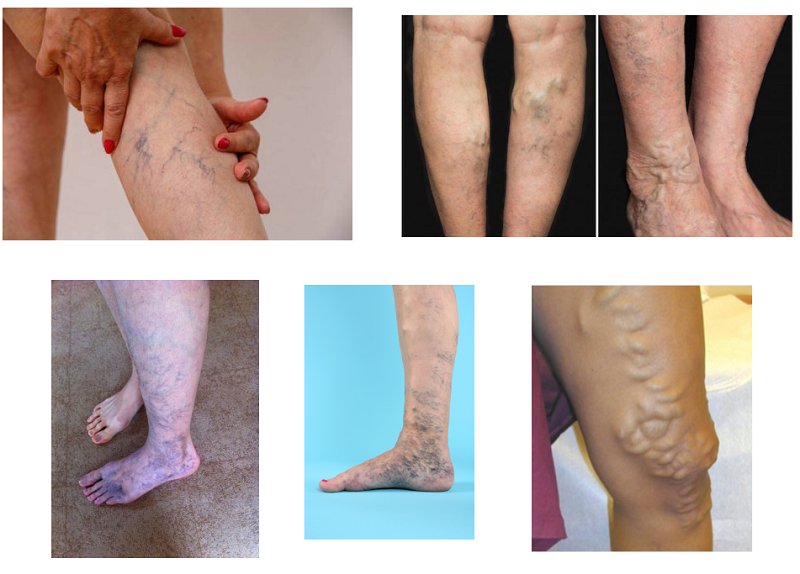
The following are symptoms of the disease:
- Veins appear dark purple or blue in color.
- The superficial blood vessels protrude prominently from the skin and the varices are lumpy or nodular.
- Swelling in the legs, discoloration, desquamation (peeling skin), itchy skin, and edema in the ankles.
- Experiencing various sensations on the lower extremities like itchiness, numbness, acanthesthesia (tingling), muscle cramping, and burning.
- The temperature of your skin rising and causing tenderness in the lower extremities.
- The diagnosis or appearance of gangrene and ulcers around a varicose vein.
What is the best treatment?
Prevention is the best treatment.
Yes, the best.
We can keep sharing more scientific medical facts with you, but you will probably end up even more worried. Ultimately, all we want to do is remind you of the importance of maintaining healthy blood circulation on your lower extremities simply by taking care of yourself.
Don’t get us wrong. It is hard to maintain a healthy lifestyle when most job activities require people to either stand or sit for extended periods. After a long, tiring workday, it’s hard to be motivated to exercise.
Be that as it may, you still need to maintain healthy blood circulation. Or else…
The Role of Compression
This is where compression socks and stockings come in handy.
As medical aids, they are effective in combating varicose veins and address different concerns. These can range from low-compression devices that help relieve minor swelling and aching of the legs to higher-level devices designed to treat severe venous stasis.
Your simple guide to compression levels
Compression stockings and compression socks typically come in four compression levels that are measured in millimeters of mercury (mmHg).
The levels are indicated with a range of numbers – for example, “20-30 mmHg,” which means that the compression level does not fall below 20 mmHg or exceed 30 mmHg.
Light compression (15-20 mmHg)
You will typically see these items over the counter at common drugstores. The low compression level is suitable for everyday wear and helps with mild swelling and fatigued legs due to long periods of standing, sitting, and traveling. It is a popular choice for office assistants, flight attendants, teachers, frequent travelers, etc.
Functionally, they:
- Prevent and relieve minor to moderate cases of varicose and spider veins
- Help relieve tired, aching legs and address minor swelling of feet, ankles, and legs
- Help prevent varicose veins and spider veins during pregnancy
- Help prevent Deep Vein Thrombosis, also known as Economy Class Syndrome
- Help prevent the reappearance of varicose veins and spider veins in post sclerotherapy treatment
Medium compression (20-30 mmHg) Medical Grade Class I Prescribed By a Doctor
The 20-30 mmHg level of compression is the first level of medical-grade compression socks (Medical Grade Class I) and prescribed by doctors for mild cases. It’s the most widely used because it provides adequate compression.
This level is suitable for varicose vein patients, people recovering from venous surgery, and pregnant women during the third trimester. Functionally, they can:
- Help prevent and relieve moderate to severe varicose veins
- Help prevent the reappearance of varicose and spider veins during post-surgical and post sclerotherapy treatments
- Help in the treatment of moderate to severe edema or lymphatic edema
- Help with the management of active ulcers and manifestations of Post-Thrombotic syndromes
- Help relieve superficial thrombophlebitis
- Help prevent Orthostatic Hypotension (or Postural Hypotension)
- Help prevent Deep Vein Thrombosis, also known as Economy Class Syndrome
High compression (30-40 mmHg)
Stronger than its Class I counterpart at 30-40 mmHg level of compression, the higher-level Medical Grade Class II items are recommended for moderate to severe leg health problems. These items are recommended for patients with lymphedema, severe varicose veins, venous reflux disease, and deep vein thrombosis.
Functionally, they:
- Help prevent and relieve severe varicose veins
- Help in the treatment of severe edema and lymphedema
- Help prevent the reappearance of varicose and spider veins in post-surgical and post sclerotherapy treatment
- Help reduce the symptoms of Orthostatic Hypotension (or Post-Thrombotic Syndrome)
- Help in the management of Venous Ulcers and manifestations of Post-Thrombotic Syndrome
- Prevent Deep Vein Thrombosis, also known as Economy Class Syndrome
Very high compression (40-50 mmHg)
Items with a 40-50 mmHg level of compression provide the strongest compression level and should not be used for regular, everyday use.
As Medical Grade Class III devices, consult your doctor before using these items, which are primarily used to treat severe venous stasis, wound management, and lymphedema. They help address:
- Acute leg/ankle swelling
- Varicose veins
- Chronic vein insufficiency
- Deep Vein Thrombosis
How to choose what’s right for you
We’ve essentially covered all the bases of compression stockings and socks — their lengths, types, material, and functions, and the different compression levels.
These are all the factors you need to take into consideration while choosing the best pair for yourself, especially when you’re wearing them to treat and prevent varicose veins. Here’s a quick summary of what we covered and some additional tips:
Material
Read the full details of what you are purchasing and choose breathable fabrics. Make sure the items you buy are made using good quality material.
If they are produced by unreliable manufacturers who use poor-quality materials, they can cause skin irritations or something worse. Poorly-made pantyhose are known to even cause gynecological diseases!
Check the full details of the product you intend to purchase to avoid any potential allergic reaction. Don’t sacrifice quality for the sake of a good bargain.
Length
Choose the length that best suits you and your day-to-day activities.

Today, compression socks and stockings come in various lengths, and what you buy should fit the lifestyle you lead. Given today’s array of choices, you are bound to find one that suits your lifestyle perfectly.
There isn’t a right or wrong answer to what length you should go for as long as you are comfortable because you know what’s best for you. 😗
Good reviews
Read the product reviews and purchase through reputable channels. Don’t make price the only consideration when making your purchase decisions.
Read reviews and ratings thoroughly – as if your life depended on it – because it probably does!
Compression level
Knowing your health condition is the key.
Wearing compression stockings and compression socks should be beneficial to your health. However, it’s also important to know the right compression level for your needs. This is key to achieving the health benefits you are looking for.
If you go too low, your item might not help at all; go too high, however, and what you’re wearing might do more harm than good.
Your ultimate takeaway from this guide on compression socks and stockings
We hope the information we’ve given will help you choose wisely items and help you prevent and treat varicose veins effectively.
Remember. Prevention is the best treatment for any disease. So, let’s start by getting your own pair today! ❤️
This page last updated December 14, 2022
